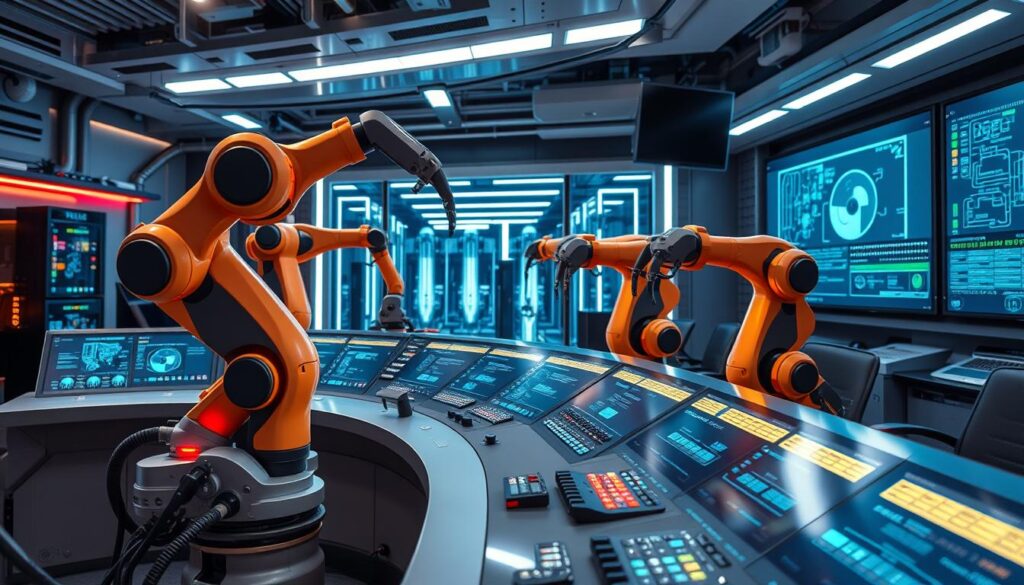Intelligent motion systems are changing the game in industrial automation. They make machines work better and faster. At the core is advanced motion control technology, which lets machines adjust in real-time for top performance.
As industries grow, the role of intelligent motion systems becomes more critical. They drive innovation and growth across many sectors.
Intelligent motion systems have changed how businesses work. They boost productivity and cut down on downtime. By using the latest in motion control technology, companies can stay competitive and increase profits.
Exploring intelligent motion systems reveals their huge potential. They make performance and reliability better, making them key to modern industrial automation.
Understanding Intelligent Motion Systems: Core Concepts
Intelligent motion systems offer precision control and real-time feedback. They make movement in different areas more efficient and accurate. These systems use advanced motion control technology to perform at their best.
The growth of motion control technology has brought big changes. Key steps include the creation of better actuators, sensors, and control units. These parts work together to control motion precisely and efficiently. They are crucial for many industries.
Some key parts of intelligent motion systems include:
- Actuators: turn energy into motion
- Sensors: give feedback on position, speed, and acceleration
- Control units: use sensor data to adjust actuator output for exact control
By combining these parts, intelligent motion systems can be very precise and efficient. They are perfect for tasks that need precision control and real-time feedback. The use of advanced motion control technology has led to the creation of complex systems. These systems can adjust to changes and improve performance.

As technology gets better, we’ll see new uses for intelligent motion systems. This will help many industries grow and get better.
| Component | Function | Importance |
|---|---|---|
| Actuators | Convert energy into motion | High |
| Sensors | Provide real-time feedback | High |
| Control units | Process data and adjust actuator output | High |
The Building Blocks of Modern Motion Control
Industrial automation needs smart motion systems for precision and energy savings. These systems fit well into many industrial processes. They give feedback in real-time to improve performance. Choosing the right parts and designing a good system can cut energy use and boost productivity.
Some important things to think about when building modern motion control systems include:
- Component selection: Picking the right motors, drives, and controllers is key for precision and energy savings.
- System design: A good system design can lower energy use and boost performance.
- Real-time feedback: Using real-time feedback helps industries adjust to changes and improve their processes.
By focusing on these areas, industries can make motion control systems that offer precision control and energy efficiency. This supports industrial automation efforts. It can save a lot of money and make things more efficient, making it a smart investment for any industry.
As industries keep changing and adopting new tech, the need for smart motion systems will grow. Understanding the basics of modern motion control and investing in the right tech is crucial. It helps industries succeed and meet their goals in a fast-changing world.
Advanced Features of Intelligent Motion Systems
Intelligent motion systems have changed how we control motion. They offer advanced features that boost performance, efficiency, and accuracy. One key feature is real-time feedback, which lets them adjust to changes and improve performance. This is thanks to smart integration, which makes them work well with other systems and devices.
Some advanced features of these systems include:
- Precision control mechanisms for accurate motion control
- Energy efficiency features to cut down on power use and costs
- Real-time feedback and adaptation to adjust to changing conditions
These features come from advanced technologies like sensors, actuators, and control algorithms. These technologies help intelligent motion systems give real-time feedback. This feedback lets them optimize performance and boost efficiency. Smart integration also lets them work well with other devices and systems, making operations more connected and efficient.
For instance, features like variable speed drives and regenerative braking can cut down energy use and costs. By adding these, intelligent motion systems become a more sustainable and cost-effective option for many applications.
In summary, the advanced features of intelligent motion systems are key. They include real-time feedback, smart integration, and energy efficiency. These features make them a great choice for industries wanting to enhance motion control and reduce environmental impact.
| Feature | Description |
|---|---|
| Real-time Feedback | Enables the system to adjust to changing conditions and optimize performance |
| Smart Integration | Facilitates seamless interaction with other systems and devices |
| Energy Efficiency Features | Help reduce power consumption and operational costs |
Industrial Applications and Use Cases
Intelligent motion systems are changing how businesses work in many fields. They help improve productivity, quality, and safety. By using motion control technology, companies can automate tasks, cut downtime, and make better products.
In manufacturing, these systems are key in assembly lines, quality checks, and packaging. They help make products quickly and well. In robotics, motion control technology makes robots do complex tasks with great precision. In healthcare, they’re in medical devices like surgical robots and patient care tools.
- Automated assembly lines
- Quality control and inspection
- Packaging and labeling
- Medical device manufacturing
- Robotic surgery and patient care
Theseindustrial applicationsshow how smart motion systems can change many industries. By usingmotion control technology, businesses can work better, save money, and make better products. This leads to growth and success for companies.
Implementation Strategies for Maximum Performance
To get the most out of intelligent motion systems, focus on system design, integration, and troubleshooting. Good system design means picking the right parts, setting up the system right, and tweaking it for the best performance. This makes sure everything works smoothly and cuts down on errors or downtime.
Integration is key, and following best practices is essential. This means linking intelligent motion systems with other parts of your setup and making sure they work with different protocols and standards. Doing this makes your operations more efficient, saves money, and boosts your competitiveness.
- Compatibility with existing systems and devices
- Scalability and flexibility to accommodate future upgrades or changes
- Security measures to protect against cyber threats and data breaches
- Regular maintenance and updates to ensure optimal performance
By sticking to these tips and focusing on system design, integration, and troubleshooting, you can get the most out of intelligent motion systems. This leads to better productivity, lower costs, and a stronger market position.
| System Design Considerations | Integration Best Practices | Troubleshooting Guidelines |
|---|---|---|
| Component selection and configuration | Compatibility with existing systems | Identifying and resolving common issues |
| System architecture and optimization | Protocol and standard compliance | Regular maintenance and updates |
| Security measures and data protection | Scalability and flexibility | Collaboration with technical support teams |
Benefits and Return on Investment
Intelligent motion systems offer many advantages to companies. They improve productivity, enhance product quality, and cut down on costs. These systems provide a great return on investment, saving money directly and indirectly.
Some key benefits include:
- Increased efficiency and productivity
- Improved product quality and reduced waste
- Reduced energy consumption and lower operational costs
- Enhanced customer satisfaction and loyalty
Investing in intelligent motion systems can save companies a lot of money. Return on investment is key to success. These systems offer a big return in many industries.
A company using intelligent motion systems will likely use less energy. This saves money and helps the environment. Better product quality and efficiency also mean happier customers. This leads to more sales and a stronger market position.
In summary, intelligent motion systems have many benefits. They offer a significant return on investment. Companies can make smart choices by understanding these benefits and savings. This improves their operations overall.
Conclusion: The Future of Intelligent Motion Systems
The future of intelligent motion systems looks very promising. Trends in artificial intelligence, the Internet of Things (IoT), and cybersecurity will change how these systems work. This will bring about a new era of high efficiency, precision, and flexibility.
AI advancements will let these systems learn from past experiences. They will get better at making decisions on their own in real-time. With IoT, they can share data and work together, improving productivity and cutting down on downtime.
It’s also crucial to add strong cybersecurity to these systems. This will keep them safe from cyber threats. As our world gets more connected, we’ll need even more secure motion control solutions.
The future of intelligent motion systems is all about innovation, efficiency, and sustainability. It will change industries and make our world smarter and more connected. By following these trends, companies can achieve better performance, agility, and a competitive edge. This will lead to a brighter and more advanced future.
FAQ
What are intelligent motion systems?
Intelligent motion systems are advanced technologies used in industry. They combine precision control, real-time feedback, and smart integration. This makes them better at what they do in many areas.
How have motion control technologies evolved over time?
Motion control has changed a lot. It started with old mechanical systems. Now, we have smart, digital systems that are more precise, save energy, and can adapt quickly.
What are the key components of intelligent motion systems?
Intelligent motion systems have a few main parts. Actuators, sensors, and control units work together. They help control motion precisely and efficiently, adapting to changes as they happen.
How do intelligent motion systems contribute to industrial automation?
Intelligent motion systems are key in making industries better. They offer precise control, save energy, and work well with other systems. This boosts productivity, quality, and safety in many fields.
What are the advanced features of intelligent motion systems?
These systems have cool features like real-time feedback and adaptation. They also have precise control, smart integration, and save energy. These help them perform better and cut costs.
Where are intelligent motion systems used in industrial applications?
You can find these systems in many places. They’re used in manufacturing, robotics, healthcare, and more. They help make things better in lots of ways.
How can companies implement intelligent motion systems effectively?
To use these systems well, companies need to think about design and integration. They should also know how to fix problems. This ensures they get the most out of their investment.
What are the benefits of using intelligent motion systems?
Using these systems brings many advantages. They improve productivity, quality, and cut costs. This makes companies more competitive and can lead to big savings.
What are the future prospects of intelligent motion systems?
The future looks bright for these systems. Advances in AI, IoT, and cybersecurity will make them even better. This will drive innovation and change how industries work.


